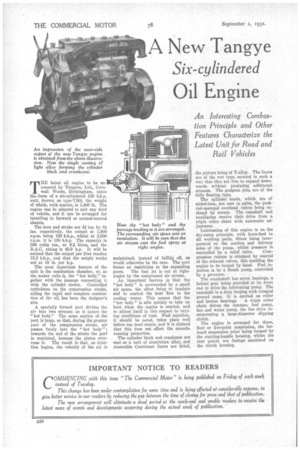A New Tangye
Page 48

If you've noticed an error in this article please click here to report it so we can fix it.
Six-cylindered
Oil Engine
An Interesting Cornbuslion Principle and Other Features Characterize the Latest Unit for Road and
Rail Vehicles
THE latest oil engine to be announced by Tangyes, Ltd., Cornwall Works, Birmingham, takes the L form of a six-cylindered 130 b.h.p. unit, known as type-VM6, the weight of which, with starter, is 1,400 lb. The engine can be adapted to suit any kind of vehicle, and it can be arranged for installing in forward or normal-control chassis.
The bore and stroke are 41 ins. by 6i ins, respectively, the output at 1,800 r.p.m. being 120 b.h.p., whilst at 2,000 r.p.tn. it is 130 b.h.p. The capacity is 566 cubic ins., or 9.2 litres, and the R.A.C. rating is 45.9 h.p. It will be noticed that the output per litre reaches 15.2 b.h.p., and that the weight works out at 10 lb. per h.p.
The most important feature of the unit is the combustion chamber, or, as the maker calls it, the "hot body," together with the passage connecting it with the cylinder crown. Controlled turbulence on the compression stroke, aiding the rapid and complete combustion of the oil, has been the designer's aim.
A specially formed port divides the air into two streams as it enters the "hot body." The cross section of the port is large, so that, during the greater part of the compression stroke, air passes freely into the "hot body " ; towards the end of the stroke the port is restricted, because the piston over
runs it. The result is that, as injection begins, the velocity of the air is
maintained, instead of falllig off, as would otherwise be the case. The port forms no restriction to the expanding
gases. The fuel jet is cut at rightangles by the compressed air stream.
An important feature is that the "hot body" is surrounded by a small air space, the effect being to insulate and to control the heat flow to the cooling water. This means that the "hot body" is able quickly to take up heat when the engine is started, and to adjust itself in this respect to varying conditions of load. Fuel injection, it should be noted, takes place well before top dead centre, and it is claimed that this does not affect the smoothrunning properties.
The cylinder block and crankcase are cast as a unit of aluminium alloy, and renewable Centricast liners are fitted, the pistons being of "1-alloy. The liners are of the wet type, secured in such a way that they are free to expand downwards without producing additional stresses. The gudgeon pins are of the fully floating type.
Tho cylinder heads, which are of nickel-iron, are cast in pairs, the pushrod-operated overhead valves being enclosed by covers. The camshaft and auxiliaries receive their drive from a triple roller chain with automatic adjustment.
Lubrication of this engine is on the dry-sump principle, with force-feed to all working parts, filters being incorporated on the suction and delivery sides of the pump, whilst pressure is
controlled by a relief valve. Compression release is obtained by control of the exhaust valves, this enabling the engine to be turned by hand. Fuel injection is by a Bosch pump, controlled by a governor.
The crankshaft has seven bearings, a helical gear being provided at its front end to drive the lubricating pump. The camshaft is a drop forging with integral ground cams. It is carried on roller and bronze bearings. A triple roller chain drives the dynamo, fuel pump, fan and water pump, the fan drive incorporating a large-diameter slipping clutch.
The engine is arranged for three, four or five-point suspension, the forward suspension point being formed by the starting-handle housing, whilst the rear points are facings machined on the clutch housing.




































































































